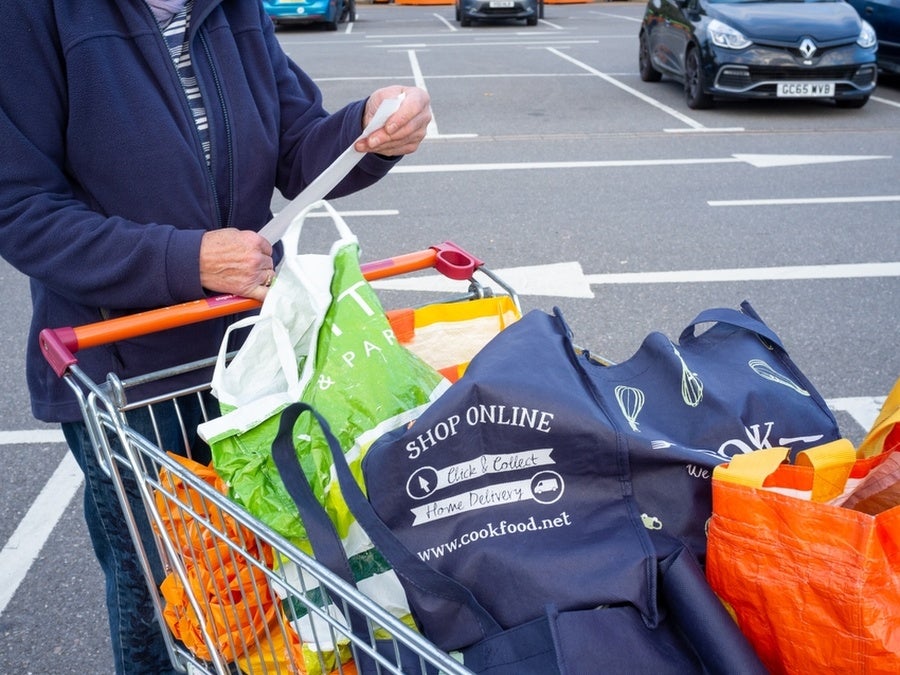
Prices of UK grocery staples eased in April but remain in double-digit inflation territory even amid some cooling in the headline numbers.
Overall inflation, for all items measured by the Office for National Statistics’ (ONS) consumer price index, rose 8.7% in the 12 months through April, down from 10.1% in March.
The latest figure is the lowest since March 2022, the month after Vladimir Putin’s invasion of Ukraine that pushed up the cost of energy, commodities and fertiliser. On a monthly basis, headline inflation pulled back to 1.2%, compared to 2.5% in April last year.
Nevertheless, the annual inflation numbers missed consensus estimates of 8.3% as food and non-alcoholic beverage prices continued to rise, albeit at a slightly slower pace than in March in some individual product areas.
Food and soft drinks prices climbed an annualised 19.1% versus 19.2% in March, which according to the ONS is the second-fastest rate since August 1977, when they rose 21.9%.
Signs of cooling were more evident in the monthly numbers, with grocery prices increasing 1.2% in April, compared to 2.1% in the same month last year.

US Tariffs are shifting - will you react or anticipate?
Don’t let policy changes catch you off guard. Stay proactive with real-time data and expert analysis.
By GlobalDataKaren Betts, the CEO of food industry body the Food and Drink Federation, once again emphasised the pressure grocery product manufacturers are under, citing disruption from the Ukraine conflict, continuing supply chain issues and the consequences of Brexit.
“It’s disappointing to see food and drink price inflation remaining at such high levels, but today’s figures underscore the huge pressure the whole food and drink supply chain continues to be under, with input costs across the board – even where these have started to fall – still much greater than they were pre-pandemic,” Betts said.
Following last week’s food summit held by Prime Minister Rishi Sunak, Betts and her industry representatives are pressing the government for assistance to relieve persistent inflationary forces.
She added: “Representatives from our sector met the Chancellor yesterday for a constructive discussion about how industry and government can work better together to tackle inflation, conscious of the very real pressure that food prices are putting on household budgets.
“We explained how companies are cutting costs wherever possible and are turning to price rises only as a last resort, but the scale of cost increases has meant that price rises have been unavoidable in many cases.”
There were some bright spots in the ONS figures today (24 May) for individual food and drink components, coming on the heels of a report from data and consulting business Kantar.
With more recent data than the ONS – for the four weeks to 14 May – Kantar said yesterday grocery inflation cooled for a second month.
Prices on a like-for-like basis rose 17.2%, with sales increasing 10.8% over the same period last year. However, grocery inflation remains at the third-fastest pace in Kantar’s records since 2008 even as it eased by one percentage point from the prior four-week period.
Evident of the pressures on consumers, growth in supermarkets’ own-label products continued to outpace branded counterparts, Kantar noted.
According to the ONS, the price of milk, cheese and eggs is still increasing at a faster pace than other staples – up 29.3% in April on an annualised basis from 29.7% in March.
The cost of bread and cereals rose 18.7%, down from 19.4% in March. Meat prices were up 17.2% versus 17.4% and fish prices rose 14.2% compared to 16.7%.
Prices for fruit climbed 10.8%, accelerating slightly from 10.6%, while it was a similar picture for vegetables, which rose 19.9% from 19.3%.
On the liquid front, the price of soft drinks increased 16% in the 12 months through April, higher than March’s 14.2% pace. Alcoholic beverages climbed 7.1%, quickening from 6% a month earlier.



